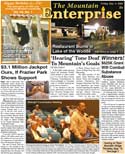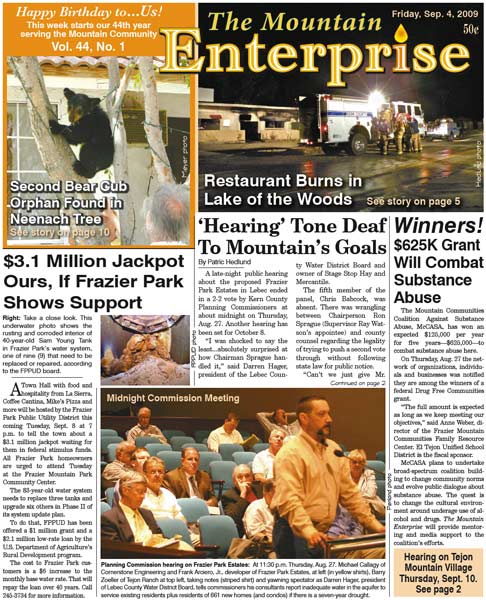The Mountain Enterprise has been asking for clarification from both Tejon Ranch Company and the U.S. Fish and Wildlife Service about the real-world consequences if California condors die or if endangered species recovery is impaired as a result of the developer’s actions under the 50-year “non-lethal” take permit.
Real World Context
With under 190 birds restored to the wild in California, each individual is precious. In May 2008, seven (7) young condors that rediscovered historical critical habitat on Tejon Ranch were found ill and had to be taken out of the wild. One died. Others had to be hospitalized and their blood chelated for life-threatening illness.
Ornithologists reported to their peers that they believe this event was associated with activities on Tejon Ranch. Similarly, in 2003, a ranch visitor shot and killed a condor matriarch.
If condors are already dying on Tejon Ranch, even before development begins, asking for a clear definition of the meaning of “non-lethal take” is not an abstract concern.
This year, the FWS declined to give a full definition until they have finished the HCP process with Tejon—long after all public comment opportunity has been closed. With no real answers from the developer or the government, we reported that the 50-year take permit would shield Tejon Mountain Village developers from liability if condor were killed or injured.
Tejon Ranch Protests
Tejon’s Barry Zoeller wrote a letter of protest to The Mountain Enterprise, saying: “The draft Tehachapi Uplands Multi-Spe-cies Habitat Conservation Plan makes it clear that the only condor ‘take’ allowed is non-lethal, specifically for the relocation of birds, by properly certified condor experts, if they become ill, injured or have become habituated to the area and need to be moved. We ask that The Mountain Enterprise immediately correct this misstatement regarding lethal take, and not repeat it in the future.”
But ‘What If?’
This newspaper replied with a renewed request for the operational definition of a 50-year “non-lethal take” permit.
We sought an outline of the steps that will be taken by the U.S. Fish and Wildlife Service if condors continue to die following the grant of such a permit. We asked:
What Are the Penalties?
What will be the range of possible consequences and possible penalties if condors are killed as development proceeds?
Will homes or commercial buildings be removed? Will the sale of parcels be rescinded? Will the incidental take permit be revoked? Will further development be prohibited?
If the answer is ‘no,’ and there are are no real consequences for the death of condors, please explain how the term ‘non-lethal take permit’ may be considered more than a marketing slogan to facilitate developers’ efforts to acquire entitlements?
This is a vital question asked by the community, but not yet answered by Tejon Ranch or the Fish and Wildlife Service.
Who Is Accountable?
If there is a plan for accountability, who will be held accountable? To what individual or to what entity would penalties be applied?
Do those who purchase the parcels inherit the liability?
Do the developing corporations retain the liability?
If so, is that liable corporation the developing LLC (in the case of Tejon Mountain Village, LLC for instance)?
Does the liability dissolve with the dissolution of the LLC? Or does liability flow through to individual members of the LLC (in the way LLC tax liabilities do), including DMB Associates, Tejon Ranch Company/Tejon Ranch shareholders?
We had hoped to report the answers to the public, but it appears there is no plan to release this information while the public comment period is still open. —P. Hedlund
[Frazier Park, Lebec, Tejon Ranch Company, Tejon Mountain Village, California Condor]
This is part of the September 04, 2009 online edition of The Mountain Enterprise.
Have an opinion on this matter? We'd like to hear from you.


